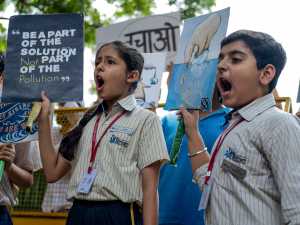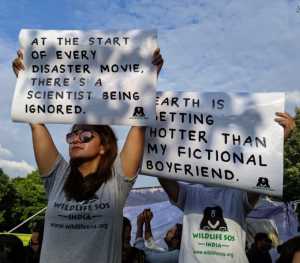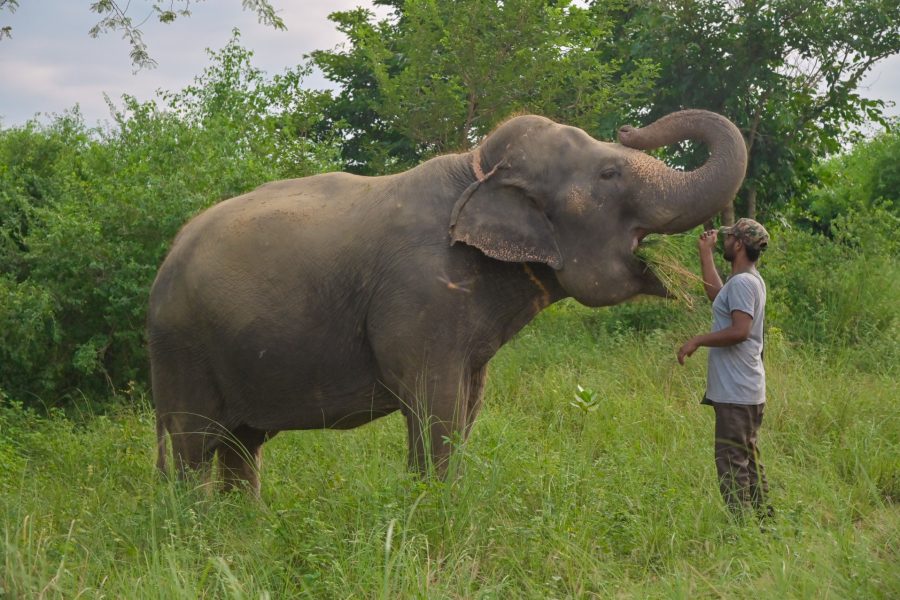“What do we want? Climate Justice.
When do we want it? Now!”
With Fridays for Future striking across the world, residents, students, and young activists took to the streets of New Delhi this month, to show their solidarity with the ongoing climate. As an organization that is working towards conserving India’s wildlife, it cannot be denied that climate change is one of the biggest threats that our physical world is facing.
Our communications team – at the Delhi Headquarters went to extend their support at the protest held in Connaught Place. Heeded by the movement by Swedish teen activist Greta Thunberg, students from Delhi NCR came with their teachers and guardians to join the march demanding quick action against the rising temperatures.
Over 500 protesters came together to demonstrate their concerns with various slogans and customized t-shirts with messages written on them. Volunteers from various environmental groups extended their support for the movement. A unified voice against climate change and placards with messages like “Don’t be a fossil” and “the oceans are rising and so are we” the protesters demanded urgent action by the government to enforce policies to save the environment. The global climate change movement can be seen as a result of the looming environmental catastrophe the world has seen in recent times. With the burning of the Amazon Rain Forests and the million tons of melted ice from the glaciers, it is high time people take action and stand up for what matters.

Temperature directly affects development, survival, range, and abundance of all the species on the earth and the consequences of climate change go way beyond warming temperatures. Climate change has the potential to unleash mega-droughts lasting 10 years or more, hints of which are seen today in many arid parts of the world. Forest fires have no direct link with the climate but recent studies suggest that the increase in wildfires in the United States is partially a result of tinder dry forests parched by warming temperatures.
The ocean temperatures, on the other hand, have risen by more than 1 degree Fahrenheit over the last century which has made a huge impact on the fragile aquatic systems of coral reefs, bleaching the reefs and putting a large number of aquatic species in danger. Sea levels are expected to rise up to 10-32 inches or higher by the end of the century. Hurricanes and other storms are likely to be stronger and floods and droughts to become more common. Less availability of freshwater reserves with glaciers making up to three-quarters of earth’s freshwater.
“Be a part of the Solution, not the pollution.”
There has been a huge shift in environmental activism in the past few years. Earlier it was a movement where only environment activists could be seen but now it is the young enthusiasts who are leading the movement. Less than a year ago, climate scientists released a warning that we are running out of time to reverse the effects of global warming. The challenge is to keep the warming below the threshold of 1.5 and it is clear that the pledges countries made during the Paris climate accord in 2015 do not take us any closer to what we had to achieve. Millions of people stood up for a unified concern making the protest an international movement.
When Greta Thunberg addressed the elites at the World Economic Forum in Davos, she commenced with a simple message “I want you to act as if our house is on fire” and when our house is on fire, we don’t talk about results in years or decades or weeks, we pick up a bucket and find some water, immediately.
With multiple consequences of equal severity, the kids and the teenagers took the responsibility into their hands to raise their voices against the authorities who remain silent. The protesters explained the urgency of acting against the climate adversity the earth has been facing for the past few decades of prolonged forbearing. The protest helped the people who have been passive resistant to the cause so far for them to share their disappointment towards the industrial revolution.

With easy means of communication and ongoing protests in the city, more people are now aware of the deteriorating conditions of our ecosystem and have joined hands to stand up against the same. We are in a unique state where we realize the threats we are exposed to and we have access to the information and technology and the political space required to address the situation but with every second of delay, the challenge becomes more difficult, more expensive and more dangerous. Globally, hundreds of thousands of people are calling for action on the climate crisis with around 350,000 people in Australia, 100,000 people in London, 270,000 in Berlin and thousands of people from more than a hundred countries, which is a remarkable number making it the largest ongoing protest in the world.
As a community, it is our responsibility to work towards a better future and take all the steps that are necessary for conserving what remains of the earth.




